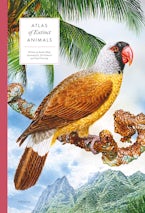"The large-format Atlas of Extinct Animals is supplemented with beautifully expressive full-page illustrations by gifted artist Jiří Grbavčič and detailed pictures by renowned scientific illustrator and multitalented Czech artist Pavel Dvorský. Dvorský reconstructs the prehistoric world in collaboration with archaeologists. The author hopes that the memory of species already gone whose stories are told here will be both our warning and our guide." —Vermont Country Book News
"Some of these animals died out thousands of years ago, but some of them still walked the earth a few years ago and now they are gone. Read
about the impact of humankind on nature and how easy a whole species can vanish from the Earth's surface and let us wonder – will humankind become
the next chapter? And they all lived happily ever after. The fairy-tale adage applies to none of the 41 creatures introduced in this atlas. Mammoth, dodo, and Neanderthal man: all extinct." ―White Ravens
"Radek Maly's Atlas of Extinct Animals, an oversized survey containing exceptionally beautiful illustrations by Jiri Grbavcic and Pavel Dvorsky. Elementary-grade readers will relish the full-page science drawings that accompany facts about the Falkland Islands Wolf, the Huia bird, the Long-Tailed Hopping Mouse, and others. Exceptional book especially recommended for creating eye-catching library displays." ―Donovans Literary Services
"Gorgeous book, more for older kids, teens, and adults. The artwork is phenomenal, and the information seems solid and well presented." —Librarian, East Hartford Public Library
"I loved reading this compilation of the intriguing and beautiful animals that used to inhabit our planet. The illustrations were an added bonus, and contributed needed visual aid in picturing not only the animal itself but the environment that they would have inhabited. An interesting, beautiful, and useful addition to any and all animal lovers library." ―Tina Hewitt, blogger
"Five out of five is the only response to a book that does exactly what it wants to do and does it better than expected.” ―John Lloyd, reviewer
"The Atlas of Extinct Animals is a beautiful book filled with incredibly detailed illustrations. As a parent who is often
asked about extinct animals or "was the dodo bird actually real?" it is great to have a resource that provides a visual example of what these extinct beings looked like as well as details about them and where they lived. Absolutely loved this book." ―Media 876444
"I cried when I read this beautifully illustrated account of 41 species and their heartbreaking demise. How could these gorgeous creatures, including the Zanzibar leopard and the Chinese river dolphin, no longer exist and what can the world do to prevent another species from being added to the list? Geared to readers aged 9 to 17, but an important reminder for adults too of the fragility of life.” ―Literary R, Reviewer
"A highly informative, no-nonsense reference text that provides insights into a variety of 41 extinct animals. Dates of extinction, scientific illustration, currently living reference animal for size comparisons, scientific name, common names, map of regional locations, and historic accounts are included. Causes for extinction are listed, where possible, based off current information. A superb resource for middle grade and high school students researching climate, ecological, and human impacts on fauna." ―Educator 901032

